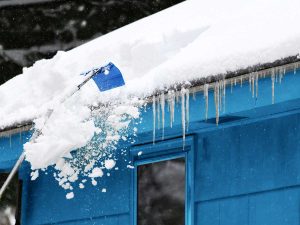Every winter, thousands of property insurance claims caused by snow and ice are reported which are preventable. Here are some useful tips that can help protect your property from snow and ice damage.
1. Snow and ice buildup on the roof
Generally speaking, Canadian homes are designed to withstand the harsh winter. But snow and ice can easily build up and all that extra weight can damage your roof.
When to clear the snow or ice from your roof
It’s time to act when there’s around 70 cm (about 2 feet) of snow or 5 cm (about 2 inches) of ice on the roof.
Snow removal tips: Be very careful when clearing snow and ice from your roof. If you’re clearing the roof yourself, work from the ground using a roof rake with a telescopic handle. Take care not to accidentally damage the roofing material and keep your tools well away from nearby hydro cables.
Note: When you clear snow, avoid damaging the roof shingles by always leaving at least a 2-inch layer of snow. That way the tools you’re using don’t come into direct contact with the roof. Improper snow removal could damage the roofing material, which may not be covered by your home insurance.
Call in the pros: That said, the dangers are real and injuries are all too common, so we recommend that you hire a professional with the right equipment and knowledge of safety procedures, especially for removing ice, which is a more difficult job.
Warning signs of water seepage
No matter how much snow or ice there is, be on the lookout for signs that water is seeping through the roof. Check the ceiling and walls on the top floor of your house for:
- Water stains or rings
- Blistering
- Water droplets
Signs of structural damage to your home
- Cracks on indoor walls
- Interior doors that start to stick, rub or not close properly
- Warped ceilings
- Unusual structural creaking
If you’re worried about the risk of water seepage or buildup of snow and ice on the roof, consult a building expert as soon as possible to prevent further damage from occurring.
Does your home insurance cover you against snow and ice damage?
If you’re insured with us, damage caused by water seepage or the weight of ice or snow is covered if your home insurance policy includes Water Damage – Above Ground Water and Weight of Ice, Snow or Sleet (Endorsement 42) coverage.
2. Ice on the edge of your roof
Those icicles hanging from the eavestrough may look pretty, but they spell trouble. They can be a sign of a potentially serious problem—ice dams.
An ice dam is a ridge of ice that forms at the edges of a sloped roof. If there’s an ice dam on your roof, it stops melting snow from draining off the roof. That means water can accumulate and seep through the walls and ceiling into your home.
Ice dams tend to be caused by poor ventilation or insulation in the attic. Heat from the house melts the snow on the roof. The melting snow flows down to the lowest part of the roof where it freezes. Ice builds up over time, creating an ice dam that blocks the flow of water from melting snow. Now this water has nowhere to go but inside your house.
How to prevent ice dams?
Here are some tips to help prevent damage caused by ice dams. Here again, we recommend that you hire a professional with the right equipment and knowledge of safety procedures.
- Regularly check the edges of your roof to make sure no ice dams have formed.
- Inspect the attic and seal any openings that could let out warm air from your home escape into the attic.
- Make sure there’s no space between the batt insulation strips (e.g., mineral wool).
- Make sure the attic is well ventilated and cool. That way, any snow on the roof will be less likely to melt and create ice dams.
- Ensure that the attic floor is well insulated to prevent heat from inside the home escaping through the roof and forming a layer of ice, which can quickly become an ice dam.
3. Snow buildup on your above-ground pool
Above-ground swimming pools are designed to withstand the weight of water in the summer, but they’re more vulnerable to the pressure of heavy snow and ice in the winter. Also, melting snow in the spring can expand (by turning into a block of ice), potentially damaging the pool, especially the cover.
You can avoid these problems by regularly clearing the snow off your swimming pool, so it’s never entirely buried under snow. Here are 4 steps for protecting your above ground pool in winter:
Remove the snow from the pool
Don’t get into the pool to shovel snow! If you do, the snow or ice could give way under your weight. This could damage the pool cover—and injure you!
Avoid damaging the rim
Use a plastic shovel to avoid scratching the edges of the pool. Also avoid walking on the coping to clear snow from the rim of the pool as this could weaken or crush the pool structure.
Don’t forget about the pool drain!
Remove snow from inside and on top of the drain to help prevent it from cracking.
Hire a professional if needed
The work will be done right and safely.
4. Maintenance of your hot tub during the cold season
Hot tubs offer an interesting alternative to enjoy the winter cold. Proper maintenance will allow you to enjoy them throughout the season and keep them functional for the rest of the year.
Always keep a shovel close to your hot tub so that you can remove snow buildup around it and to avoid falling on the ice when you get out of it.
Hot tub Cover:
- Avoid snow and ice buildup during the winter, otherwise you may need to replace your spa cover in the spring.
- To remove snow and ice, use a soft-bristled broom instead of a shovel or other sharp tools as this may cause damage to the vinyl.
- Having a quality hot tub cover, designed for the climate in your area, provides added protection for your hot tub during the winter and helps also reduce your heating costs. If your area usually receives a lot of snow, a cover with a 6-inch (about 15 cm) foam thickness is highly recommended.
Protective Cover:
- Although a well insulated cover is a must for our harsh winters, a protective cover will also provide additional protection for both your hot tub and hot tub cover.
- The protective cover is made of polyethylene resin and is installed over your spa cover. It will help keep debris, snow, and ice out of your hot tub.
If you keep your hot tub running throughout the winter
Cleaning the filters:
It is important to clean the filters in the fall. A dirty filter can prevent proper operation of the hot tub in the winter because if the water flow is not sufficient to operate the heater and power pack, it will shut down the hot tub (as a safeguard to prevent it from overheating).
Water Temperature:
Be sure to check the water temperature frequently to see if the heater is operating properly.
Water Level:
Pay attention to the water level during the winter season. If it is too low, the pumps will shut down and the water in your hot tub will cool or even turn to ice, causing possibly damage to your hot tub and plumbing system.
5. Protect other parts of your home
Stairs, doors and balconies
Remove snow or ice right away. Remember to be thorough—especially if they’re used as emergency exits.
Temporary carports
Temporary carports aren’t designed to withstand excessive snow and ice buildup, so it’s important to clear them regularly. They can collapse under the weight of snow, so try to work from the outside rather than the inside when removing snow.
Oil and gas appliances
Make sure there’s adequate clearance around tanks and pipes and that they’re easily accessible and protected should snow and ice fall from the roof.
To find out more, call 1-888-476-8737 or visit thepersonal.com/https://ospe.on.ca/wp-content/uploads/2024/10/academy-banner-7.png
This article is being provided by OSPE on behalf of The Personal which has a group sponsorship agreement with regards to home and auto insurance for our members. The Personal refers to The Personal General Insurance Inc. in Quebec and The Personal Insurance Company in all other provinces and territories of Canada. The information and advice in this article are provided for informational purposes only. The Personal shall not be liable for any damages arising from any reliance upon such information or advice. The Personal recommends using caution and consulting an expert for comprehensive, expert advice. Auto Insurance is not available in MB, SK and BC due to government-run plans.






Leave a Comment